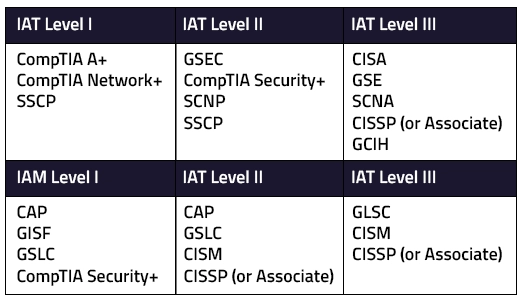The Certified Information Systems Security Professional certification is the most recognized in information security today and has been so for quite some time now. A CISSP certification validates the certification holder’s deep technical and managerial knowledge as well as the experience of information security professionals to effectively design, engineer, and manage the overall security posture of an organization. The CISSP certification is relevant and valuable across multiple disciplines and industries, not staying limited just to the IT space, and can be highly desirable for an individual in any industry focusing on building and maintaining information systems security.
The CISSP certification by (ISC)2 meets the US Department of Defense (DoD) 8570 IAM Level II/III, IAT Level III, and IASAE Level I/II requirements. It is the first cybersecurity certification to comply with the renowned ANSI/ISO/IEC 17024 standards.
What is the CISSP certification?
CISSP stands for Certified Information Systems Security Professional certification. It is a vendor-neutral credential that shows that the certification holder knows how to design, implement, and manage a best-in-class cybersecurity program in any environment. Since this is a vendor-neutral certification, it makes for a great fit for all professionals to avoid limitations and expenses that come with a vendor lock-in that ties up the organization and can become a significant bottleneck.
According to (ISC)2, CISSP is well-suited for information security professionals seeking to prove their understanding of cybersecurity strategies and hands-on implementation. It shows that the certification holder has the advanced knowledge & technical skills to design, develop, and manage an organization’s overall security posture.
What are IAM and IAT levels?
IAM and IAT are qualification standards established by the US Department of Defense in 2004 to ensure that the Department of Defense IT systems are staffed with technical & management personnel who meet a certain standard of technical expertise.
What is IAT?
IAT stands for Information Assurance Technical. The IAT certification levels entail some specific certification exams and work experiences that need to be cleared/met to attain those levels. The IAT requirements are focused on technical knowledge and are geared toward the technical staff.
There are three category levels in IAT – Level I represents computing environment information assurance, Level II represents network environment information assurance, and Level III represents enclave, advanced network, and computer information assurance. Within each of these levels, sub-levels are representing the attainment grades – entry-level, intermediate level, and advanced level. Each of these levels further has a set of functions under it.
The CISSP certification is not required for IAT roles until Level III. This is especially so since CISSP is a more management-focused certification, while the lower level IAT roles would be more technical in nature, and having the CISSP knowledge would not be too helpful in those roles, could be good to have but not essential definitely until the individual gets into a more management-level role.
What is IAM?
IAM stands for Information Assurance Management. The IAM certification levels entail some specific certification exams and work experiences that need to be cleared/met to attain those levels. The IAM requirements are focused on technical knowledge and are geared toward the leadership staff.
Both IAM and IAT have three certification levels – I, II, and III. Level I is beginner-level, level II is an intermediate level, while level III is the expert level.
Any personnel working an IAM Level III job is required to have a minimum of 10 years of management experience. They need to be working in an enclave environment. The personnel would also need to be involved in effectively applying the knowledge of the information assurance policy, procedures, and workforce structures for developing, implementing, and maintaining a secure enclave environment.
IAM roles are more suited for the CISSP certification and the certification is fits the requirements for both IAM Level II and Level III. If your goal is to take up a management position in cybersecurity and information security, CISSP could be a huge feather in your cap, besides being immensely helpful to you.
CISSP is a Level II/III, IAT Level III certification demonstrating expert-level knowledge and experience.
Why are the IAT and IAM Levels important?
There are two reasons to mention here. One, if your goal is to at some point in your career work as a government cybersecurity professional, working with Information Assurance, then have a DoD Directive 8570.1 approved certification. This specific directive applies to information security professionals who are involved in identifying, tagging, tracking, and managing cybersecurity/IA in the government workforce.
To meet the DoD 8750 compliance requirements, you would need to have earned an approved cybersecurity certification or do the same within six months. CISSP is one of these certifications.
The below table should give you some idea about the different approved certifications at different levels:

The other reason is, that even if you do not aspire to work in the US DoD in cybersecurity, no matter what part of the world or what organization – government or non-government you choose to work for, having a certification that is compliant with the US DoD is not just prestigious but also a high-level, thorough validation of your skills and knowledge in the field of information security.
There has been a recent update to Directive 8750, and the new directive is the DoD 8140. So, double-check the requirements before you get on board. The DoDD 8140 now establishes a detailed definition for the cyber workforce and outlines the component roles & responsibilities for the management of the DoD cyber workforce.

Get CISSP training
Once you have employees with the CISSP certification, they will demonstrate their skills to benefit your business with –
- Complete understanding of how to secure or protect confidential business data from hackers.
- Analyze risks and be aware of the common hacker strategies that can affect your business. They can determine the weak points of the organizations and work on them.
- Aptitude in improving not only the customer but also employee privacy ensuring all the information stays with the business only.
Get (ISC)2 CISSP Training & Certification and increase your business visibility as well as credibility in the cybersecurity market. Cognixia is the world’s leading digital talent transformation company that offers a wide range of courses, including CISSP training online with a comprehensive CISSP study guide.
Here’s what you will cover in this course –
- Learn and apply the concepts of security & risk management
- Gain an understanding of security engineering to protect information by exploring and examining security models and frameworks
- Learn how to identify, categorize, & prioritize assets
- Examination and security network architecture and its components
- Learn how to identify & control access to protect assets
- Designing and conducting security assessment strategies, logging, & monitoring activities
- Developing a recovery strategy and maintaining operational resilience
- Learn how to secure the software development cycle
Prerequisites For CISSP Training & Certification
- Candidates for the CISSP certification should have at least 5 years of total paid work experience in two or more of the 8 CISSP CBK domains. Any extra certificate from the (ISC)2 authorized list, a four-year college degree, or a regional equivalent would qualify as one year of the necessary experience.
- If a candidate doesn’t have enough experience to qualify as a CISSP, they can still become an Associate of (ISC)2 by completing the CISSP test. After that, they will have 6 years to acquire the 5 years of necessary experience.

